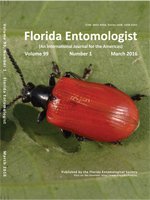Agraulis vanillae vanillae L. (Lepidoptera: Nymphalidae) is a pest of Passiflora species (Malpighiales: Passifloraceae). The parasitism of A. vanillae vanillae pupae by Palmistichus elaeisis Delvare & LaSalle (Hymenoptera: Eulophidae) was evaluated. Ten 72-h-old mated P. elaeisis females were confined for 48 h with each 24-h-old A. vanillae vanillae pupa. These exposed pupae were transferred to glass tubes until the emergence of the parasitoid adults. The percentages of parasitism and emergence, number that emerged, sex ratio, body size, width of the head capsule, and longevity of P. elaeisis females and males were similar to those of P. elaeisis reared with various other hosts. These results this indicated that it is practical to rear this parasitoid with A. vanillae vanillae pupae to provide the parasitoid for use in biological control programs.
Damage to crops by insects necessitates the use of chemical control, which, in turn, can affect predators and parasitoids (Castro et al. 2012). Therefore, either biological control or other methods of pest control that are compatible with biological control should be developed to protect crops, tree plantations, and forests from very damaging pests.
The pest Agraulis vanillae vanillae L. (Lepidoptera: Nymphalidae) feeds exclusively on Passiflora (Malpighiales: Passifloraceae) plants (Ross et al. 2001), and Palmistichus elaeisis Delvare & LaSalle (Hymenoptera: Eulophidae) was reported to parasitize the pupae of another nymphalid passion fruit pest Dione juno juno Cramer (Lepidoptera: Nymphalidae) (Gil-Santana & Tavares 2006). This gregarious parasitoid has also been reported to parasitize various other lepidopteran species (Gil-Santana & Tavares 2006; Pereira et al. 2008; Tavares et al. 2012a,b, 2013). Furthermore, it can be reared with Bombyx mori L. (Lepidoptera: Bombycidae) (Pereira et al. 2009, 2010a,b) and Tenebrio molitor L. (Coleoptera: Tenebrionidae) (Zanuncio et al. 2008). The aim of this study was to evaluate the reproductive characteristics of P. elaeisis reared on A. vanillae vanillae pupae.
This research was conducted at the Federal University of Viçosa in Viçosa, Minas Gerais State, Brazil, at 25 ± 2 °C, a photoperiod of 12:12 h L:D, and 70± 10% relative humidity. Thirty 4th-instar A. vanillae vanillae larvae were collected on Passiflora plants in Viçosa and placed in the laboratory on leaves of this plant under controlled conditions until pupation. Twenty A. vanillae vanillae pupae, 24 h old, were individualized in glass tubes (14 × 2.2 cm) plugged with cotton, and were provided honey droplets. Each pupa was exposed for 48 h to 10 mated P. elaeisis females, each 72 h old (Pereira et al. 2009).
The tubes, with the host pupae and parasitoids, were observed daily until offspring emerged. The duration of the life cycle, number of individuals per pupa, percentage of parasitism, progeny sex ratio (number of females / number of adults), body size, width of the head capsule, and longevity of P. elaeisis adults were obtained. The measurements were made with an ocular micrometer attached to a stereoscopic microscope (Pereira et al. 2010a,b). Palmistichus elaeisis adults were sexed based on their antennae and abdomens (Delvare & LaSalle 1993).
The percentage of parasitism and emergence of P. elaeisis were 95 and 90%, respectively. The life cycle (egg to adult) lasted 18.61 ±0.32 d, and the number of P. elaeisis individuals per pupa was 225.53 ± 19.57. A typical parasitized pupa with emergence holes is shown in Fig. 1. The body size, the width of the head capsule, and the longevity of P. elaeisis females and males are shown in Table 1. The sex ratio of the parasitoids that emerged from A. vanillae vanillae pupae was 0.93.
The body sizes and widths of head capsules of P. elaeisis females and males that emerged from A. vanillae vanillae pupae were similar to those of individuals that emerged from T. molitor (Zanuncio et al. 2008), B. mori (Pereira et al. 2010a,b), and Heraclides anchisiades capys Hübner (Lepidoptera: Papilionidae) (Tavares et al. 2013). However, size, age, and quality of host pupae can affect the characteristics of parasitoids (López et al. 2009). The sex ratio of P. elaeisis from A. vanillae vanillae pupae was similar to those recorded from other lepidopteran pupae (Pereira et al. 2010a,b; Zanuncio et al. 2008). This relative constancy of morphological and life characteristics is due to the generalist behavior of P. elaeisis, which can be reared either with lepidopteran or with coleopteran pupae (Gil-Santana & Tavares 2006; Zanuncio et al. 2008).
This is the first report of P. elaeisis parasitizing A. vanillae vanillae pupae in the laboratory, and this parasitoid can be reared with this host for the biological control of this pest.
We acknowledge financial support by Conselho Nacional de Desenvolvimento Científico e Tecnológico (CNPq), Coordenação de Aperfeiçoamento de Pessoal de Nível Superior (CAPES), and Fundação de Amparo à Pesquisa do Estado de Minas Gerais (FAPEMIG). Global Edico Services corrected and edited the English language of the submitted version of this manuscript.
Table 1.
Characteristics of Palmistichus elaeisis females and males that emerged from Agraulis vanillae vanillae pupae.







